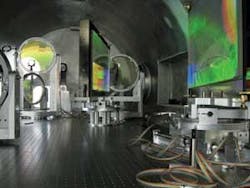CHIRPED-PULSE AMPLIFICATION: Petawatt now, exawatt on the horizon

Completed in early 2008 at the University of Texas at Austin, the Texas Petawatt is a 200 J, 150 fs, mixed-glass, optical-parametric chirped-pulse-amplifier (OPCPA) laser that has reached a peak power output of 1.1 petawatts (1.1 × 1015 W)–more than 2000 times the power output of the entire U.S. electrical grid. And now, according to Todd Ditmire, project director, and Mikael Martinez, project manager, it appears possible to use the technology developed for the laser in future work toward developing an exawatt (1018 W) laser.
Mixed-glass gain material
The Texas Petawatt laser uses new ultra-high-power laser technology and older, well-demonstrated technology from high-energy fusion lasers such as Shiva, Nova, and the National Ignition Facility (NIF) laser (all developed at Lawrence Livermore National Laboratory in Livermore, CA). As described by Ditmire and Martinez, the laser design is a hybrid approach of three main laser technologies.
First is chirped-pulse amplification (CPA), which has been a pioneering development in driving lasers to terawatt and petawatt laser powers. Additionally, optical parametric amplification (OPA) enables high gain (107) over short path lengths (100 mm) with a broad bandwidth (greater than 50 nm). The final technology is a novel approach that uses two different types of laser glass (Nd:phosphate and Nd:silicate) to provide large-aperture amplifiers (31.5 cm) and high-energy extraction (greater than 200 J). Using the two different materials enables broad-bandwidth (greater than 15 nm) pulses that can be compressed to pulse durations of 150 fs–much smaller that the typical 400 to 500 fs pulse durations currently available by using only one glass type.
Involvement of the commercial world
Continuum (Santa Clara, CA) supplied two major technologies used in the Texas Petawatt. The first was a commercially available laser specifically designed to pump an OPCPA. “Continuum worked with our group and other collaborators at Lawrence Livermore National Laboratory to develop a high-fidelity 532 nm laser, delivering 4 J pulses that have a flat-top profile in both time and space,” says Ditmire. “This technology is critical in demonstrating the stable, high-energy OPCPA front end for the Texas Petawatt.” Second, Continuum used rod-amplifier technology that was developed with Lawrence Livermore National Laboratory for the NIF laser and provided a 64 mm rod amplifier for use in the mixed-glass stage of the Texas Petawatt.
The Texas Petawatt began construction in 2004 with funding from the National Nuclear Security Administration (Washington, D.C.). The laser facility is situated in the basement of the Physics building on the main campus of The University of Texas at Austin. The laser was completed March 31, 2008, allowing an immediate demonstration of its 1.1 petawatt power by producing, 200 J, 167 fs pulses.
“Since completion of the laser system, we have commissioned the target area to conduct a wide range of high-energy-density physics research,” says Ditmire. “The first experiments now under way involve the irradiation of a gas jet formed of small clusters of deuterium molecules. By irradiating these small clusters with the petawatt pulse, plasmas with temperatures sufficient to trigger nuclear fusion are achieved and the blast of fusion neutrons that occurs is measured. The hope is to use these neutrons for materials-science studies. Future experiments with the Petawatt will include acceleration of electrons to GeV energies and the creation of hot, dense plasma states that approximate those found in the center of some exotic stars such as brown dwarfs.”
Toward exawatt powers
The new hybrid CPA technology developed on the Texas Petawatt can be the foundation for an exawatt-laser effort, says Martinez. Construction of an exawatt laser would push the envelope of current laser technology and push the United States well into the lead in ultrahigh-power laser science. “Such an exawatt laser would use OPCPA in the front part of the system and would be coupled to a high-gain chain of Nd:glass amplifiers,” says Ditmire. “The bandwidth requirements of such a system will require the development of new laser glasses that deliver even broader gain bandwidth than existing commercially available glasses.”

John Wallace | Senior Technical Editor (1998-2022)
John Wallace was with Laser Focus World for nearly 25 years, retiring in late June 2022. He obtained a bachelor's degree in mechanical engineering and physics at Rutgers University and a master's in optical engineering at the University of Rochester. Before becoming an editor, John worked as an engineer at RCA, Exxon, Eastman Kodak, and GCA Corporation.